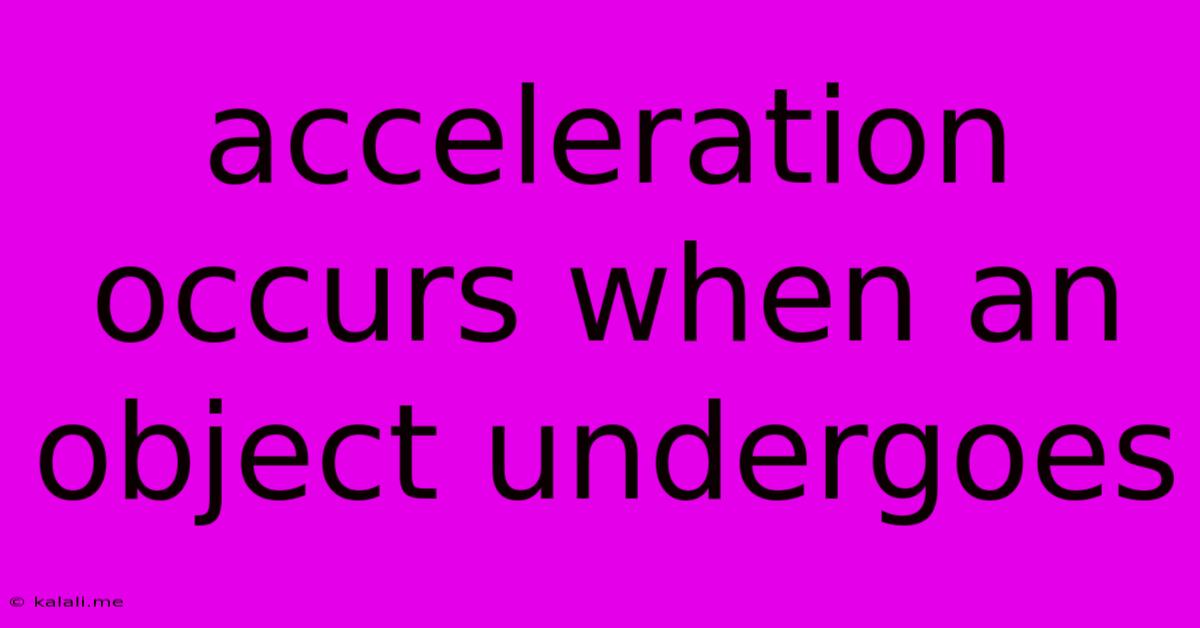Acceleration Occurs When An Object Undergoes
Kalali
Jun 14, 2025 · 3 min read

Table of Contents
Acceleration: When Objects Change Their Velocity
Acceleration is a fundamental concept in physics, often misunderstood as simply speeding up. While increasing speed is one type of acceleration, it's actually a more comprehensive term describing any change in an object's velocity. This means acceleration encompasses changes in speed, direction, or both. Understanding this nuance is crucial to grasping the complexities of motion.
This article will delve into the intricacies of acceleration, explaining what it is, the factors that influence it, and providing real-world examples to illustrate the concept. We'll also explore the relationship between acceleration, velocity, and displacement.
What is Acceleration?
In simple terms, acceleration is the rate at which an object's velocity changes over time. Velocity, unlike speed, is a vector quantity, meaning it has both magnitude (speed) and direction. Therefore, a change in either speed or direction, or both, constitutes acceleration.
The formula for calculating average acceleration is:
a = (v<sub>f</sub> - v<sub>i</sub>) / t
Where:
- a represents acceleration
- v<sub>f</sub> represents final velocity
- v<sub>i</sub> represents initial velocity
- t represents the time interval
The unit for acceleration is typically meters per second squared (m/s²).
Types of Acceleration
There are several types of acceleration, depending on the nature of the velocity change:
- Positive Acceleration: Occurs when an object's speed increases. A car accelerating from a stoplight experiences positive acceleration.
- Negative Acceleration (Deceleration): Occurs when an object's speed decreases. A car braking to a stop experiences negative acceleration, also known as deceleration or retardation.
- Uniform Acceleration: Occurs when an object's velocity changes at a constant rate. This means the acceleration remains constant throughout the motion. The classic example is an object falling freely under the influence of gravity (neglecting air resistance).
- Non-Uniform Acceleration: Occurs when an object's velocity changes at a non-constant rate. A car accelerating rapidly and then slowing down experiences non-uniform acceleration.
- Centripetal Acceleration: This is a special type of acceleration that occurs when an object moves in a circular path at a constant speed. Although the speed remains constant, the direction is constantly changing, resulting in acceleration towards the center of the circle. Think of a car rounding a curve.
Factors Affecting Acceleration
Several factors influence the acceleration of an object:
- Net Force: The greater the net force acting on an object, the greater its acceleration. Newton's second law of motion (F = ma) states that the acceleration of an object is directly proportional to the net force acting on it and inversely proportional to its mass.
- Mass: The greater the mass of an object, the smaller its acceleration for a given net force. A heavier object requires a larger force to achieve the same acceleration as a lighter object.
Real-World Examples of Acceleration
Acceleration is everywhere in our daily lives:
- A rocket launching into space: Experiences immense positive acceleration.
- A ball rolling down a hill: Undergoes positive acceleration due to gravity.
- A car braking to a stop: Experiences negative acceleration (deceleration).
- A rollercoaster: Experiences both positive and negative acceleration, as well as centripetal acceleration during turns.
- A planet orbiting the sun: Undergoes centripetal acceleration, constantly changing direction while maintaining (relatively) constant speed.
Understanding the Relationship Between Acceleration, Velocity, and Displacement
Acceleration is the rate of change of velocity, and velocity is the rate of change of displacement (position). These three quantities are interconnected and crucial for understanding motion. Analyzing graphs of displacement vs. time, velocity vs. time, and acceleration vs. time can provide valuable insights into an object's movement.
In conclusion, acceleration is far more than just speeding up; it's a change in velocity, encompassing both speed and direction. By understanding the different types of acceleration and the factors that influence it, we can better comprehend the motion of objects around us, from everyday occurrences to complex celestial mechanics.
Latest Posts
Latest Posts
-
What Is The Least Common Multiple Of 10 And 14
Jun 15, 2025
-
How Much Is Four Hundred Thousand
Jun 15, 2025
-
Who Was The First To Stab Caesar
Jun 15, 2025
-
Words That Describe A Good Mother
Jun 15, 2025
-
Which Statement Is True About Fossils
Jun 15, 2025
Related Post
Thank you for visiting our website which covers about Acceleration Occurs When An Object Undergoes . We hope the information provided has been useful to you. Feel free to contact us if you have any questions or need further assistance. See you next time and don't miss to bookmark.